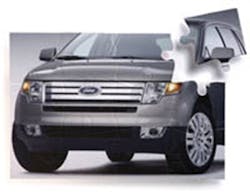Crossover puzzle
Years from now, new car, pickup and SUV dealers will probably remember 2007 with something other than fondness. Sales of both new cars and light trucks throughout the United States and Canada declined sharply last year. New car sales fell by more than 202,000 units and light truck (including SUV) sales dropped by more than 212,000 units, according to Wards Automotive.
On the other hand, dealers who sold crossover vehicles will recall 2007 as the year in which those vehicles -- which have been called everything from “souped-up station wagons” to “an amalgamation of minivan, car and SUV” -- came into their own.
More than 2.7 million crossovers were sold throughout the United States and Canada during 2007, an increase if 417,000 from the previous year. Crossover vehicle sales are expected to top the 3 million mark by the end of 2008, challenging small cars as the industry’s largest segment.
While crossover vehicle sales boom, sales of large pickups and traditional SUVs continue to decline, spurred on by a number of factors.
What’s derailing SUV sales? Why are crossover sales booming? What kinds of tires are coming on crossover vehicles? Here’s what auto manufacturers recently told Modern Tire Dealer.
[PAGEBREAK]
‘Convergence of factors’
No other automobile category “even comes close” to crossover vehicles in terms of growth, says George Pipas, Ford Motor Co. sales analysis and reporting. Ford’s crossover sales grew 62% last year, “more than triple the industry average.”
SUV sales went the other way, and Pipas says that trend will continue. He predicts SUV sales will decline to 1.5 million units by 2010.
“The most popular reason given for this dramatic shift is higher gas prices.” But he says there’s more to the story. “As recently as the first quarter of 2004, the average price of unleaded gas was $1.68;” SUVs were still selling. “Gas prices were still in the $2 range throughout 2004 and 2005.” Meanwhile, SUVs continued to move off lots during those years.
Spiking gas prices during 2006 “accelerated the decline in traditional SUVs,” explains Pipas, but the shift to crossovers from SUVs, “as much as anything, has been caused by number one, demographic factors, and number two, (availability of) product.”
Demographic factors can be attributed to empty nest baby boomers. “The baby boomer generation has the most significant impact on the types of vehicles being purchased in the U.S. They buy a disproportionate share of new vehicles.
“In the 1980’s, this generation was getting married, buying houses, starting families and buying minivans. As their kids grew up, they opted for bigger vehicles like full-size SUVs.
“But by this current decade, many boomers have become empty-nesters, and they’re getting older, too. They don’t need a vehicle as big as what they once had.
“Product availability also has been important. At the beginning of this decade, there were only 14 crossovers offered by auto manufacturers,” he reports. “Now there are about 60, and in another year, there will be around 70. There are more vehicles to choose from in this category.”
“People are moving out of traditional SUVs, but they don’t want to go back to a traditional sedan,” says Phil O’Connor, senior model line manager for crossovers, Nissan North America Inc. “Crossovers offer the types of product benefits that people are looking for without the trade-offs that come with SUVs,” including higher fuel consumption.
Pipas agrees that former SUV owners are unlikely to return to them. “I don’t care if gas goes back to $1.50 -- the die has been cast.”
[PAGEBREAK]
Tire design
What are crossover vehicle manufacturers looking for in tires? “Crossovers can carry up to eight passengers, so the biggest (factor) is the tire’s load carrying capacity. It has to handle the load,” says Keith Mueller, General Motors Corp. vehicle performance engineer.
Once load is determined, “we approach different tire manufacturers and ask them to put in a bid. Then we hash out the specs for the rest of the tire.
“We ask for a size: what the fundamental width of the tire will be. Then we spec what we call ‘cornering coefficient’ -- the slip of the tire. We spec numbers that relate to how strong the tire is from a handling point of view. We give them requirements on rolling resistance and how it relates to fuel economy. We also specify the weight of the tire. Then we set requirements for wet and snow traction.”
GM also specifies noise parameters, which are particularly important for its more upscale models. “We tell them the kind of cake we want and they figure out how to bake it,” says Sue Morales, vehicle chief engineer for GM. The company rarely, if ever, specs an already-existing tire on a new crossover, she and Mueller note.
The tire development process entails a lot of back-and-forth between GM and its tire supplier. “It always comes back to putting the tire on the vehicle and doing a test ride evaluation,” says Mueller.
